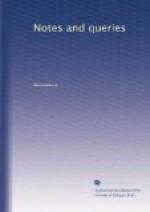EDWARD F. RIMBAULT.
Nash’s Terrors of the Night.—Excessively rare. Boswell had a copy, and another is in the library of the Earl of Ellesmere, described in Mr. Collier’s Bridgewater Catalogue as one of the worst of Nash’s tracts.
L.
Tureen (No. 25. p. 407.).—The valuable reference to Knox proves the etymology from the Latin. Terrene, as an adjective, occurs in old English. See quotation in Halliwell, p. 859.
L.
English Translations of Erasmus’ Encomium Moriae (No. 24. p. 385.).—Sir Thomas Challoner’s translation of Erasmus’ Praise of Folly was first printed, I believe, in 1540. Subsequent impressions are dated 1549, 1569, 1577. In 1566, William Pickering had a license “for pryntinge of a mery and pleasaunt history, donne in tymes paste by Erasmus Roterdamus,” which possibly might be an impression of the Praise of Folly. (See Collier’s Extracts from the Registers of the Stationers’ Company, vol. i. p. 125.). This popular work was again translated in the latter part of the following century, by White Kennet. It was printed at Oxford in 1683, under the title of Wit against Wisdom, or a Panegyric upon Folly. This is in all probability the intermediate translation inquired after by your correspondent.
EDWARD F. RIMBAULT.
In answer to “JARLZBERG,” I beg to inform him of the following translation of Erasmus’ Praise of Folly:—
“Moriae Encomium, or the Praise of Folly, made English from the Latin of Erasmus by W. Kennet, of S. Edm. Hall, Oxon, now Lord Bishop of Peterborough. Adorn’d with 46 copper plates, and the effigies of Erasmus and Sir Thos. More, all neatly engraved from the designs of the celebrated Hans Holbeine. 4th edition. 1724.”
Kennett, however, in his preface, dated 1683, alludes to two other translations, and to Sir Thomas Challoner’s as the first. He does not mention the name of the second translator, but alludes to him as “the modern translator,” and as having lost a good deal of the wit of the book by having “tied himself so strictly to a literal observance of the Latin.” This is his excuse for offering to the public a third translation, in which he professes to have allowed himself such “elbow-room of expression as the humoursomeness of the subject and the idiom of the language did invite.”
HERMES.
The intermediate translation of the Moriae Encomium of Erasmus, to which your correspondent refers, is that by John Wilson, 8vo. London 1661, of which there is a copy in the Bodleian.
M.
Oxford.
Court of Wards.—I cannot tell “J.B.” (No. 11. p. 173.) anything about Mr. D’Israeli’s researches in the Court of Wards; but “J.B.” may be glad to know that there is among the MSS. in the British Museum a treatise on the Court of Wards. I remember seeing it, but have not read it. I dare say it might be usefully published, for we know little in detail about the Court of Wards.




